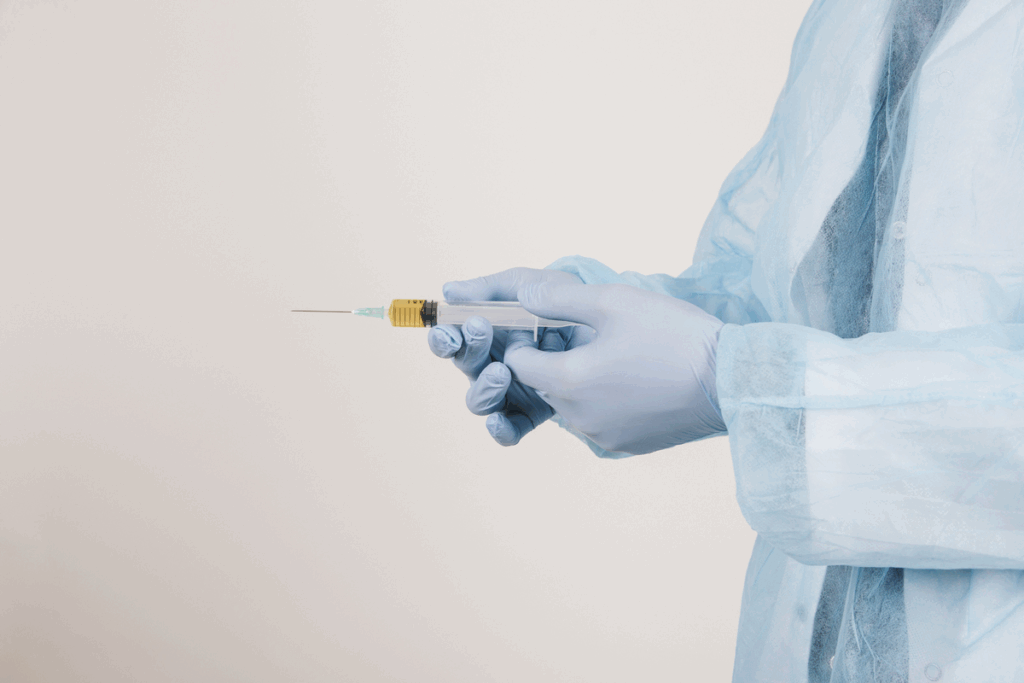
At Liv Hospital, we know you might worry about epidural steroid injections and herniated discs. You might ask, “can epidural cause herniated disc” or if these injections can hurt your back or if they’re safe.
Studies show that epidural injections don’t usually cause herniated discs. But, if the technique is wrong or if you already have disc problems, it could lead to nerve or disc damage.
We’ll look into the link between epidural injections and herniated discs. We’ll cover how often they’re used, their safety, and what you should know about them.

To understand epidural injections and herniated discs, we need to know what each is. Epidural injections are a treatment, and herniated discs are a condition that causes pain.
An epidural injection puts medicine around the spinal cord. It’s used to ease pain and swelling from spinal issues, like herniated discs. The medicine includes a steroid to cut down swelling and a local anesthetic to block pain.
Epidural steroid injections are a less invasive treatment. Studies show they can help a lot with herniated disc symptoms. They aim to lessen pain and swelling, helping patients get back to their daily activities.
A herniated disc happens when the soft center of the disc leaks out. This can bother nearby nerves, leading to pain, numbness, or weakness in the back or legs. Herniated discs often come from aging, injury, or wear and tear.
Knowing about herniated discs helps pick the right treatment. Often, steroid injections are suggested to handle the pain and swelling.
“Epidural shot,” “steroid injection,” and “cortisone shot” mean the same thing. They involve putting steroids into the epidural space to fight inflammation. A cortisone shot is the same, as cortisone is a steroid. These shots help with spinal issues, like herniated discs, by reducing pain and swelling.
It’s key to know these terms to talk with doctors and choose the right treatment.

To understand if epidural injections can lead to herniated discs, we need to look at the latest research. We’ll explore the possible dangers of these injections and how they might affect discs.
Research on epidural injections has given us important information. It shows that while these injections are mostly safe, there are risks. These risks include nerve or disc damage.
Experts agree that epidural injections are not usually the main cause of herniated discs. But, if done wrong or if you have health issues beforehand, the risk goes up.
People with existing disc problems are more at risk from epidural injections. Those with pre-existing disc degeneration or vulnerability face a higher chance of complications.
It’s key to check for these conditions before getting an epidural. This means doing detailed tests to see if it’s safe for you.
The way an epidural is done can also affect the risk of a herniated disc. Bad needle placement or injection method can harm the disc or nerves, causing problems.
Getting epidural injections from skilled healthcare professionals is important. They should use the right techniques and have the right tools. This reduces the risk of issues.
Epidural steroid injections are a common treatment for herniated discs. They aim to reduce inflammation and ease pain.
Steroid injections deliver anti-inflammatory medication to the epidural space. This area is around the spinal cord. It helps reduce swelling and irritation from a herniated disc, easing pain and discomfort.
Key benefits of steroid injections include:
The anti-inflammatory effect of steroid injections comes from suppressing inflammatory cytokines. This reduces swelling in the affected area. It helps in easing pain and improving mobility and function.
Corticosteroids, the active ingredients, are strong anti-inflammatory agents. They are used to manage various inflammatory conditions, including those from herniated discs.
The length of pain relief from an epidural steroid injection varies. Some people may feel relief for weeks or months, while others might find it shorter.
Several factors affect how long pain relief lasts:
Knowing these factors and having realistic expectations helps patients make better treatment choices.
For those with herniated discs, knowing about epidural steroid injections is key. These injections help manage pain from herniated discs. There are several types, each with its own benefits.
Transforaminal injections put steroids into the spinal nerve foramina. This targets the nerve root irritated by the herniated disc. The Cleveland Clinic says it’s great for pain that follows a specific nerve path.
Interlaminar injections go between the vertebrae’s laminae. This spreads the steroid medication widely. It’s good for central disc herniations or when many nerve roots are affected.
Caudal injections go into the caudal space through the sacral hiatus. It’s often used for lower back pain. It’s seen as safer than other methods.
Choosing the right injection depends on the disc’s location and severity, the patient’s health, and symptoms. Medical experts say,
“The key to successful treatment lies in selecting the most appropriate injection technique based on the individual patient’s condition.”
This tailored approach makes sure patients get the best treatment for their needs.
It’s important to know how often you can get epidural steroid injections to manage back pain. These injections help with spinal conditions like herniated discs.
Doctors usually say you can get these injections three or four times a year. But, it depends on your needs and how well you respond to the treatment.
We follow strict guidelines to make sure these injections are safe and effective. We decide how often to give them based on your situation.
It’s key to wait a bit between injections. Usually, it’s a few weeks to see if the last one worked and to avoid side effects.
Recommended Waiting Periods:
| Injection Type | Minimum Waiting Period |
| Epidural Steroid Injections | 2-3 weeks |
| Transforaminal Epidural Steroid Injections | 3-4 weeks |
| Caudal Epidural Injections | 2-4 weeks |
Several things can change how often you get these injections. The severity of your condition, your health, and how you react to the injections are important.
For example, people with chronic conditions might need more injections. Others might need to limit steroid use due to health issues.
There are also limits to how many injections you can have in your lifetime. Guidelines suggest not exceeding a certain number to avoid long-term side effects.
We help you find the best treatment plan. We weigh the benefits of injections against the risks. We also look at other treatment options when needed.
Many people wonder about the safety of steroid shots for herniated discs. These injections are usually safe but can have risks and side effects.
Most people do well with epidural steroid injections. But, some might feel pain or discomfort where the shot was given. They might also have mild allergic reactions or see their blood sugar levels go up if they have diabetes. It’s important to talk to your doctor about any worries you have to know the good and bad.
Though rare, serious problems like infections, nerve damage, or spinal cord injuries can happen. These issues are not common, but knowing about them is key. Knowing the risks helps patients make better choices.
Using steroids in these injections can lead to issues like weight gain, mood swings, and problems with the adrenal glands. There’s also worry about how these shots might affect bone health over time or lead to dependency on steroids.
To lower the risks of these injections, several steps can be taken. Doctors use the smallest amount of steroid needed and precise techniques. They also pick patients carefully based on their health history. These steps help doctors reduce the chance of serious problems.
In summary, while steroid shots are mostly safe for herniated discs, it’s important to know about possible side effects and serious issues. Being informed and working with your doctor helps you make the best choices for your health.
Cortisone injections are a common treatment for slipped discs. They help reduce inflammation and ease pain from herniated discs.
Research shows cortisone injections can greatly help with pain from slipped discs. But, how well they work varies. The success rate can be between 50% to 80%.
This depends on how bad the herniation is and the patient’s health. A study in the Journal of Neurosurgery: Spine found big improvements in pain and function for those who got injections.
Several things can affect how well cortisone injections work. These include:
Knowing these factors helps predict treatment success with cortisone injections.
It’s important to compare cortisone injections with other treatments for slipped discs. Here’s a table comparing them:
| Treatment | Success Rate | Duration of Relief |
| Cortisone Injections | 50-80% | Several weeks to months |
| Physical Therapy | 60-70% | Ongoing with regular therapy |
| Surgery | 80-90% | Permanent, but with surgical risks |
This table shows how cortisone injections compare to other treatments. It helps patients and doctors choose the best treatment.
Learning about the epidural shot procedure for herniated disk can make you feel more at ease. We’ll guide you through each step, from getting ready to recovering. This way, you’ll know exactly what to expect.
Before getting an epidural steroid injection for a herniated disk, several steps are taken. These steps ensure the procedure is safe and effective.
The injection process involves several important steps:
After the procedure, you’ll be watched for a short time. This is to check for any immediate reactions or complications.
By understanding the epidural shot procedure for herniated disk, you can better prepare for the treatment and recovery. If you have any concerns or questions, it’s important to talk to your healthcare provider.
There are many alternative and complementary treatments for herniated discs. These options give patients choices beyond traditional methods.
Conservative management is often the first step for herniated discs. It includes:
These methods can be very effective. They help manage symptoms and aid in recovery without surgery.
For those who don’t get better with conservative methods, there are minimally invasive options. These include:
In some cases, surgery is needed for herniated discs. This is when there’s significant nerve damage or when other treatments fail. Surgical options include:
Surgery is usually a last resort but can offer significant relief for some.
Often, the best treatment combines different methods. For example, a patient might do physical therapy and get epidural steroid injections. This mix can make treatment more effective and improve results.
Healthcare providers can tailor treatment plans by considering various alternatives. This way, they meet the unique needs of patients with herniated discs.
Epidural injections are a common treatment for herniated discs. They help relieve pain and inflammation. It’s important to know the benefits, risks, and alternatives to make good choices about your care.
Before getting an epidural injection, talk to healthcare professionals. They can tell you the best treatment for your condition. They’ll also explain how often you can get the injection and what to expect.
Think about the benefits and risks of epidural injections. Consider your own situation. Then, talk to a healthcare professional. They can help you find the best treatment for your herniated disc.
An epidural steroid injection is a procedure. It involves injecting a corticosteroid into the space around the spinal cord. This helps reduce inflammation and relieve pain from a herniated disc.
Some studies suggest a link between epidural injections and disc herniation. But, the risk is considered low. The injections are generally safe when done correctly.
The timing of epidural steroid injections varies. But, guidelines suggest giving them at least several weeks apart. You should not get more than three injections a year.
There are three main types of epidural injections. These include transforaminal, interlaminar, and caudal injections. Each has its own benefits and characteristics.
Steroid injections can cause side effects. These include pain or discomfort at the injection site, flushing, insomnia, and mood changes.
Cortisone injections can help reduce pain and inflammation from slipped discs. Success rates vary based on individual factors and the condition’s severity.
During the procedure, you’ll get the injection under guidance. Afterward, you might feel some discomfort or side effects. Most people can go back to normal activities soon after.
Yes, there are other treatments. These include physical therapy, pain medications, and lifestyle changes. There are also minimally invasive options and surgery in some cases.
Getting epidural steroid injections after spine surgery depends on your situation. It depends on the type of surgery and your spine’s current condition. Always consult a healthcare professional.
Pain relief from epidural steroid injections can last differently for everyone. It can range from a few weeks to several months or even longer.
Subscribe to our e-newsletter to stay informed about the latest innovations in the world of health and exclusive offers!
WhatsApp us